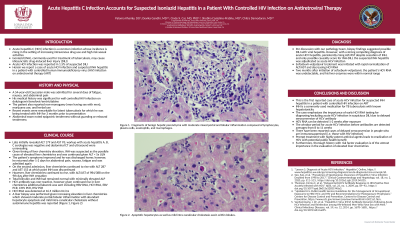Back


Poster Session C - Monday Afternoon
Category: Liver
C0585 - Acute Hepatitis C Infection Accounts for Suspected Isoniazid Hepatitis in a Patient With Controlled HIV Infection on Antiretroviral Therapy
Monday, October 24, 2022
3:00 PM – 5:00 PM ET
Location: Crown Ballroom

Has Audio

Paloma Khamly, DO
Loma Linda University
Redlands, CA
Presenting Author(s)
Paloma Khamly, DO1, Devika Gandhi, MD2, Cindy X. Cai, MD, PhD3, Shobha Castelino-Prabhu, MD4, Chitra Damodaran, MD4
1Loma Linda University, Redlands, CA; 2Loma Linda University, Loma Linda, CA; 3VA Loma Linda Healthcare System, Loma Linda University School of Medicine, University of California Riverside School of Medicine, Loma Linda, CA; 4Loma Linda VAH, Loma Linda, CA
Introduction: Acute hepatitis C (HCV) infection is rising in intravenous drug users/non-monogamy. Isoniazid (INH), commonly used for tuberculosis, may cause idiosyncratic drug-induced liver injury (DILI). Acute HCV infection was reported in 1.5% of suspected DILI. We here report a case of acute HCV infection for suspicious INH hepatitis in a patient with controlled human immunodeficiency virus (HIV) infection on antiretroviral therapy (ART).
Case Description/Methods: A 54 years-old Caucasian male was admitted for several days of fatigue/nausea/abdominal pain with elevated ALT/AST at 179/93. He has a history of controlled HIV infection on dolutegravir/tenofovir/emtricitabine, non-monogamy (men having sex with men), marijuana/herbal use, and latent tuberculosis (with a normal liver test/negative HCV antibody) treated with INH for 3 months. Serology for acute hepatitis A, B, C infection, other work-ups, and abdominal ultrasound/CT were negative. INH rather than ART/herbals was suspected as the possible culprit for hepatotoxicity and was continued due to ALT < 5 times upper normal limit. Patient was discharged after a negative esophagogastroduodenoscopy and symptomatic improvement. He presented again 2 days later with ALT/AST of 287/153 then to 984/388 on the 9th day after INH cessation. Total bilirubin and INR had remained normal with minimally elevated ALP. HCV RNA was detected at 16.5 million IU/ml. A liver biopsy was performed for rising liver enzymes and excluding autoimmune hepatitis. Moderate portal/lobular inflammation with abundant hepatocyte apoptosis and mild intra-canalicular cholestasis without autoimmune hepatitis was reported, suggesting possible DILI with viral hepatitis per pathologist. However, with a strong competing diagnosis of acute HCV hepatitis, persistently rising ALT/AST despite cessation of INH, and only possible causality score for INH-DILI, the suspected INH hepatitis was adjudicated as acute HCV infection. Sofosbuvir-velpatasvir treatment was initiated with rapid normalization of ALT/AST and decreasing HCV RNA.
Discussion: This is the first reported case of acute HCV infection for suspected INH hepatitis in a patient with controlled HIV infection on ART. The case emphasizes the importance of early HCV RNA testing for diagnosing/excluding acute HCV infection in suspicious DILI due to delayed seroconversion of HCV antibody. Prompt treatment with highly potent antiviral agents leads to eradication of HCV with potential public health benefit.
Disclosures:
Paloma Khamly, DO1, Devika Gandhi, MD2, Cindy X. Cai, MD, PhD3, Shobha Castelino-Prabhu, MD4, Chitra Damodaran, MD4. C0585 - Acute Hepatitis C Infection Accounts for Suspected Isoniazid Hepatitis in a Patient With Controlled HIV Infection on Antiretroviral Therapy, ACG 2022 Annual Scientific Meeting Abstracts. Charlotte, NC: American College of Gastroenterology.
1Loma Linda University, Redlands, CA; 2Loma Linda University, Loma Linda, CA; 3VA Loma Linda Healthcare System, Loma Linda University School of Medicine, University of California Riverside School of Medicine, Loma Linda, CA; 4Loma Linda VAH, Loma Linda, CA
Introduction: Acute hepatitis C (HCV) infection is rising in intravenous drug users/non-monogamy. Isoniazid (INH), commonly used for tuberculosis, may cause idiosyncratic drug-induced liver injury (DILI). Acute HCV infection was reported in 1.5% of suspected DILI. We here report a case of acute HCV infection for suspicious INH hepatitis in a patient with controlled human immunodeficiency virus (HIV) infection on antiretroviral therapy (ART).
Case Description/Methods: A 54 years-old Caucasian male was admitted for several days of fatigue/nausea/abdominal pain with elevated ALT/AST at 179/93. He has a history of controlled HIV infection on dolutegravir/tenofovir/emtricitabine, non-monogamy (men having sex with men), marijuana/herbal use, and latent tuberculosis (with a normal liver test/negative HCV antibody) treated with INH for 3 months. Serology for acute hepatitis A, B, C infection, other work-ups, and abdominal ultrasound/CT were negative. INH rather than ART/herbals was suspected as the possible culprit for hepatotoxicity and was continued due to ALT < 5 times upper normal limit. Patient was discharged after a negative esophagogastroduodenoscopy and symptomatic improvement. He presented again 2 days later with ALT/AST of 287/153 then to 984/388 on the 9th day after INH cessation. Total bilirubin and INR had remained normal with minimally elevated ALP. HCV RNA was detected at 16.5 million IU/ml. A liver biopsy was performed for rising liver enzymes and excluding autoimmune hepatitis. Moderate portal/lobular inflammation with abundant hepatocyte apoptosis and mild intra-canalicular cholestasis without autoimmune hepatitis was reported, suggesting possible DILI with viral hepatitis per pathologist. However, with a strong competing diagnosis of acute HCV hepatitis, persistently rising ALT/AST despite cessation of INH, and only possible causality score for INH-DILI, the suspected INH hepatitis was adjudicated as acute HCV infection. Sofosbuvir-velpatasvir treatment was initiated with rapid normalization of ALT/AST and decreasing HCV RNA.
Discussion: This is the first reported case of acute HCV infection for suspected INH hepatitis in a patient with controlled HIV infection on ART. The case emphasizes the importance of early HCV RNA testing for diagnosing/excluding acute HCV infection in suspicious DILI due to delayed seroconversion of HCV antibody. Prompt treatment with highly potent antiviral agents leads to eradication of HCV with potential public health benefit.
Disclosures:
Paloma Khamly indicated no relevant financial relationships.
Devika Gandhi indicated no relevant financial relationships.
Cindy Cai indicated no relevant financial relationships.
Shobha Castelino-Prabhu indicated no relevant financial relationships.
Chitra Damodaran indicated no relevant financial relationships.
Paloma Khamly, DO1, Devika Gandhi, MD2, Cindy X. Cai, MD, PhD3, Shobha Castelino-Prabhu, MD4, Chitra Damodaran, MD4. C0585 - Acute Hepatitis C Infection Accounts for Suspected Isoniazid Hepatitis in a Patient With Controlled HIV Infection on Antiretroviral Therapy, ACG 2022 Annual Scientific Meeting Abstracts. Charlotte, NC: American College of Gastroenterology.
